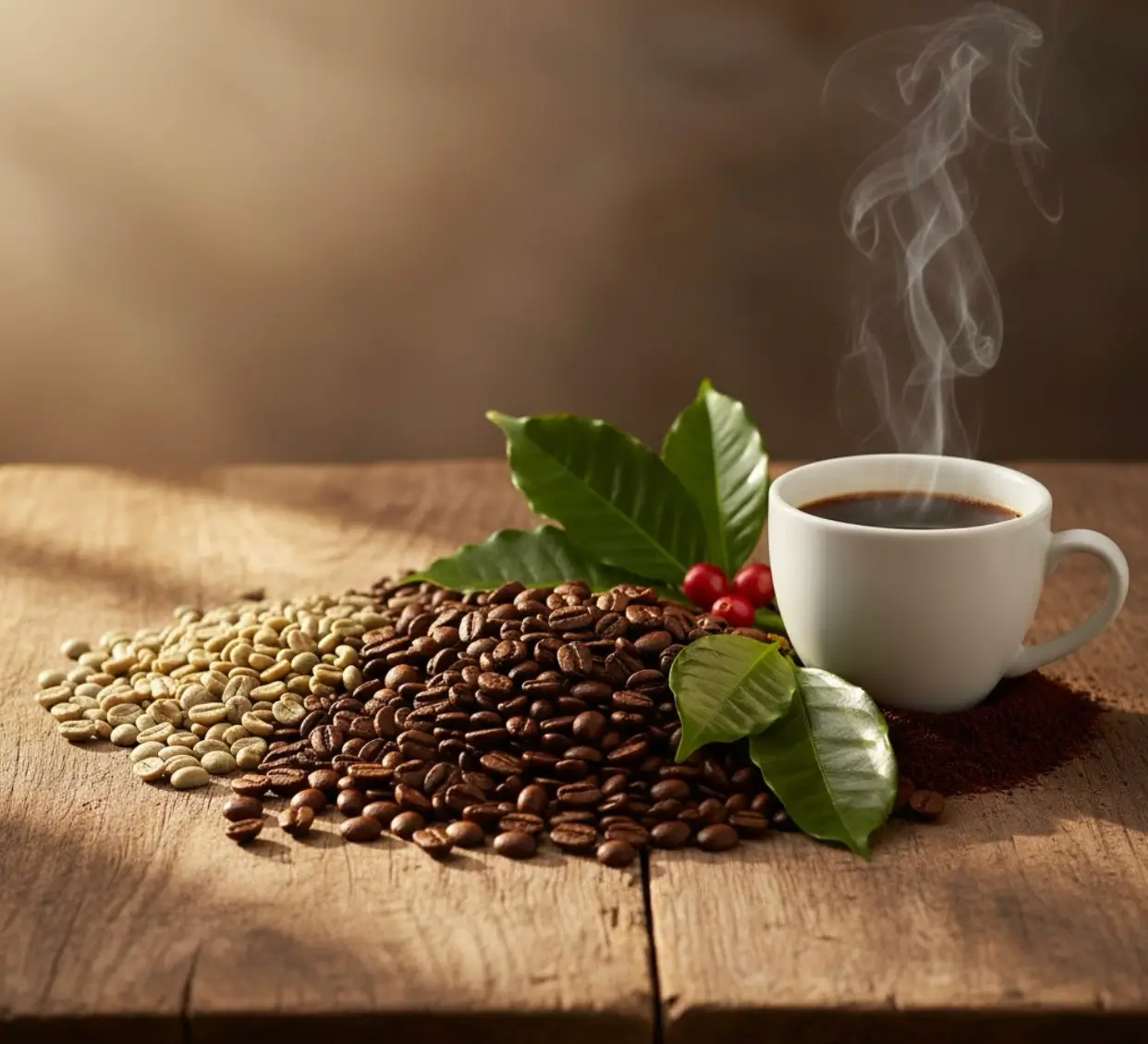Coffee truly is a global ritual, right? Billions of us start our day with it, or maybe grab a cup later on. You might wonder, “What is coffee made of?” Many people just think it’s water and roasted beans. But there’s so much more to it – a whole journey, far more intricate than just brewing.
- What is the core raw material for coffee?
- How does a coffee cherry become a green bean?
- What are the main coffee bean varieties: Arabica vs. Robusta?
- What else do you need for coffee cultivation beyond the bean?
- What is inside a raw coffee bean: The chemical blueprint?
- What are the main macronutrients and organic compounds in a coffee bean?
- What compounds contribute to coffee’s flavor, aroma & energizing properties?
- What is the transformation process from green bean to brewed coffee?
- How are ripe coffee cherries harvested?
- How are coffee beans processed to extract the bean?
- How are green coffee beans dried & milled for roasting?
- How does roasting develop coffee’s flavor and aroma?
- What are the final steps: Grinding & brewing coffee?
- What else is coffee made of: Common additions and flavor enhancers?
- What is coffee made of in summary?
To really get what coffee is made of, you need to see where it comes from, its chemical makeup, and all the ways it changes. Let’s look at everything that makes up your coffee, from that first little cherry to the amazing cup in your hand. We’ll explore the whole coffee production process.
What is the core raw material for coffee?
The main ingredient for coffee is the green coffee bean. Growers pick these from the fruit of the coffee plant, which we call the coffee cherry. These aren’t actually “beans” botanically; they’re the seeds nestled inside those bright fruits.
You can’t make coffee without these raw coffee seeds. They’re the starting point for everything.
How does a coffee cherry become a green bean?
The journey from a coffee cherry to a green bean starts when workers harvest the ripe fruit. They then carefully process these cherries to remove their outer layers.
This step reveals the ‘green coffee bean,’ ready for roasting. The way you process coffee really changes its final taste.
What are the main coffee bean varieties: Arabica vs. Robusta?
Most of the world’s coffee comes from two main varieties: Arabica and Robusta. Each has its own story, growing needs, look, and chemical differences.
These differences change how they taste and how the coffee world uses them. Knowing these distinctions helps you appreciate many coffee experiences.
Arabica Coffee (Coffea arabica) began in the high forests of South Ethiopia. Today, you find it in Central and South America, and East Africa. People often love Arabica for its smooth, sweet, and acidic taste. It makes up 60-75% of global coffee production. Arabica beans contain more fats and sugars than Robusta.
Robusta Coffee (Coffea canephora) mostly grows in West Africa and parts of Asia. It likes hotter climates and lower elevations. This plant is tougher, resisting pests and diseases, which makes it easier to grow. Robusta beans have almost twice the caffeine of Arabica. This means a stronger, more bitter flavor, often earthy and harsh. You find it a lot in instant coffee and espresso blends.
Here’s a look at how these two varieties compare:
| Characteristic | Arabica Coffee | Robusta Coffee |
|---|---|---|
| Origin | South Ethiopia | West Africa, parts of Asia |
| Growing Conditions | High altitudes, specific rainfall, mild temperatures | Lower altitudes, hotter climates, more resilient |
| Caffeine Content | ~1.5% (lower) | ~2.7% (higher) |
| Lipids & Sugars | Higher (sweeter, complex flavor) | Lower (less sweet, more bitter) |
| Flavor Profile | Lighter, sweeter, acidic, fruity, floral, nutty | Stronger, more bitter, earthy, harsher, rubbery notes |
| Bean Appearance | Larger, oval, flatter, prominent crease | Smaller, rounder, straighter crease |
| Global Production | 60-75% | 25-40% |
What else do you need for coffee cultivation beyond the bean?
Beyond the actual green coffee bean, growing healthy coffee plants needs other farm materials. These help the plants from seedling to harvest, making sure you get good quality beans.
Good coffee cultivation relies on these extra resources. Farmers manage them carefully to support the coffee plant’s life cycle.
- Seedlings: Young coffee plants are a must for starting new farms. Growers often raise these in nurseries for months before moving them to the fields.
- Soil amendments and fertilizers: Farmers regularly add nutrients to the soil. This keeps the plants growing strong and healthy.
- Pest and disease management products: Protecting coffee crops from pests and diseases is important for survival and quality. Solutions range from organic sprays to specific chemical treatments.
- Water resources: A steady and enough water supply is key, especially when it’s dry. Irrigation or natural rain keeps the plants healthy throughout their growth.
- Shade trees: Many coffee farms use shade trees. These protect coffee plants from direct sun, lower water stress, and improve soil. This can also help the beans develop better flavor.
- Companion plants: Some farmers plant other crops next to coffee. These might add nitrogen to the soil, keep pests away, or give farmers another source of income. This approach benefits the whole farm ecosystem.
What is inside a raw coffee bean: The chemical blueprint?
The chemicals inside raw green coffee beans are what eventually create coffee’s flavor, smell, and kick when you roast them. These compounds don’t have much flavor when they’re raw.
Looking at what makes up a coffee bean shows you the science behind coffee’s taste and smell. Raw coffee beans hold a lot of flavor potential.
What are the main macronutrients and organic compounds in a coffee bean?
Raw green coffee beans mainly contain macronutrients and other organic compounds. These build the bean’s structure and its future flavor. Carbohydrates make up most of their weight.
These parts create the raw material’s nutrition and chemistry. They change a lot during roasting.
The main things in raw coffee beans by weight include:
- Carbohydrates: These make up about 60% of the bean’s dry weight. They’re mostly polysaccharides like cellulose and arabinogalactans. Sugars, such as sucrose, are also there and add sweetness when roasted.
- Fats (Lipids): Around 13% of the raw bean is fat. Fats really affect how brewed coffee feels in your mouth. Diterpenes, like cafestol and kahweol, are also in this fat part.
- Proteins and amino acids: Proteins make up about 13% of the bean. They help create flavor compounds during roasting through something called the Maillard reaction.
- Acids: You’ll find different organic acids, like chlorogenic, citric, malic, and quinic acid. These give coffee its acidity and its complex flavor.
- Tannins: These polyphenolic compounds are in smaller amounts and can add a bit of bitterness.
- Alkaloids: Caffeine is the most famous alkaloid. It gives coffee its energizing properties. Trigonelline is another important compound.
What compounds contribute to coffee’s flavor, aroma & energizing properties?
Certain compounds give coffee its taste, smell, and energizing kick. These include caffeine, chlorogenic acids (CGA), trigonelline, diterpenes, melanoidins, and many volatile aromatic compounds. They all interact and change when you roast and brew coffee.
Each compound helps create coffee’s unique taste, smell, and energy. The balance of these elements makes coffee so appealing.
- Caffeine: This compound is the main energy booster. It blocks certain receptors in your brain, making you feel alert. It also makes coffee taste a bit bitter.
- Chlorogenic acids (CGA): You find a lot of these in green coffee. They add to bitterness and acidity. When you roast the beans, CGA breaks down into other compounds, which then change the flavor and smell even more.
- Trigonelline: This compound gives coffee sweet and earthy notes. It breaks down during roasting, creating other compounds that add to the typical coffee flavor and smell.
- Diterpenes (Cafestol and Kahweol): These oily compounds give coffee its body and texture, especially in unfiltered brews. They can also affect cholesterol levels.
- Melanoidins: These brown compounds form during roasting from the Maillard reaction. They add a lot to coffee’s body, rich color, and savory-sweet flavors. They also have antioxidants.
- Volatile aromatic compounds: Roasting creates hundreds of these. They make coffee smell the way it does. Think of pyrazines for nutty smells, aldehydes for fruity notes, and furans for caramel. Together, they create coffee’s unique scent.
What is the transformation process from green bean to brewed coffee?
Taking a green coffee bean and turning it into a delicious cup of brewed coffee needs a series of steps. These stages are key to getting the best out of the beans.
The whole coffee production process shapes the final characteristics of the coffee you drink. Each step really changes the final taste and smell.
How are ripe coffee cherries harvested?
Harvesting is the first step in the coffee production process. Workers carefully pick ripe coffee cherries from the plants. They can do this by hand or with machines.
After picking, they sort these fresh cherries to remove any that are not ripe, too ripe, or damaged. Good harvesting means only the best cherries move on.
How are coffee beans processed to extract the bean?
After harvesting, coffee cherries get processed to remove their outer layers and get out the inner green coffee bean. Farmers use three main ways, and each gives the coffee a different taste.
These ways are basic to coffee processing. They really change the coffee’s flavor. The method you pick affects sweetness, body, and acidity.
- Washed (Wet) process: This method first removes the cherry’s skin and most of the pulp mechanically. Then, fermentation in water removes the sticky layer (mucilage), followed by washing and drying. This process usually makes cleaner, brighter, and more acidic coffees.
- Natural (Dry) process: In this older method, whole coffee cherries dry in the sun, often on raised beds. After drying, workers remove the skin and pulp. The beans soak up flavors from the drying fruit. This gives coffees a heavier body, lower acidity, and strong fruity or fermented notes.
- Honey (Pulp natural) process: This method partly removes the cherry skin and pulp, but leaves some mucilage (the ‘honey’) on the bean while it dries. It mixes parts of both washed and natural processes. This often gives coffees extra sweetness, balanced acidity, and a full body.
How are green coffee beans dried & milled for roasting?
After processing, green coffee beans dry to lower their water content. This stops them from spoiling and keeps them good. This step gets them ready for long-term storage and then roasting.
Once dry, the beans go to milling. Here, farmers remove any remaining protective layers and sort them for quality. This stage gives you the ‘green coffee,’ ready for the next change.
- Drying: Coffee beans dry either naturally in the sun on patios or raised beds, or in big mechanical dryers. The goal is to get moisture from about 60% down to 10-12%. This is ideal for storage and roasting.
- Milling: This process removes the parchment layer that still covers the dried bean. We call this hulling. After hulling, workers polish the beans, sort them by size and density, and grade them for quality. This makes sure the final product is consistent.
How does roasting develop coffee’s flavor and aroma?
Coffee roasting is where green coffee beans heat up to very high temperatures, usually between 180°C and 250°C. This heat dramatically creates coffee’s special flavor and aroma.
During roasting, sugars caramelize, acids change, and new aromatic compounds form through reactions like the Maillard reaction. How light or dark you roast the beans really changes the final taste, color, and even how much caffeine you feel.
What are the final steps: Grinding & brewing coffee?
The last steps in making coffee involve grinding the roasted beans and then brewing them with hot water. These stages bring out the rich flavors and aromas from roasting, giving you the finished drink.
Both the grind size and your brewing method really affect how much flavor you get out and how good the final cup is. Freshness at these stages matters most for great taste.
- Grinding: You grind roasted coffee beans to a specific size just before brewing. The grind size is key. It decides how well water can pull flavors from the coffee particles. For example, espresso needs a very fine grind. Pour-over methods use a medium-fine grind, and a French press needs a coarse grind.
- Brewing: You then steep ground coffee or run hot water through it. The brewing method, water temperature, contact time, and coffee-to-water ratio all affect how much dissolves into your cup. They shape the coffee’s final taste, body, and aroma.
The table below summarizes these steps:
| Step | Purpose | Key Factors | Impact on Final Cup |
|---|---|---|---|
| Grinding | Prepare beans for water extraction | Grind size (fine, medium, coarse), freshness | Extraction rate, flavor clarity, bitterness, body |
| Brewing | Extract flavor into water | Method (espresso, pour-over, French press), water temperature, brew time | Strength, aroma, flavor profile, mouthfeel |
What else is coffee made of: Common additions and flavor enhancers?
Beyond the basic bean and water, coffee often has other things added to it. People use these to change its flavor and make many different drinks. These coffee additives range from natural sweeteners to rich flavorings.
These additions turn a simple black coffee into a custom drink, often more indulgent. They let you create a huge variety of coffee tastes.
- Natural sweeteners: Many people like adding honey, maple syrup, or agave syrup to their coffee for sweetness. These offer different, subtle flavors compared to white sugar.
- Spices: Spices like cinnamon, nutmeg, cardamom, and even star anise are popular. They give coffee warm, exotic, or comforting notes, making the whole experience better.
- Flavor syrups and sauces: Commercial flavor syrups and sauces, like caramel, vanilla, hazelnut, or dark chocolate, create popular coffeehouse drinks. These give strong flavors and sweetness.
- Fats and creaminess enhancers: Things like butter or even a spoonful of peanut butter can add richness and a unique feel in your mouth. This is common in some coffee traditions.
- Milk and milk alternatives: Dairy milk (whole, skim, cream) and many plant-based milk alternatives (almond, soy, oat, coconut) are often added to lighten coffee. They add creaminess and new flavors.
What is coffee made of in summary?
So, what is coffee made of? Coffee is much more than just a drink. It’s about understanding its raw materials, its chemical makeup, and all the ways it changes from bean to cup. From that little coffee cherry to the carefully roasted green coffee bean, every step creates its unique identity.
The way chemical compounds interact, the specific characteristics of Arabica vs Robusta, and every stage of the coffee production process all lead to the diverse and loved drink we enjoy. This journey shows you coffee’s deep story and why we love it so much.









